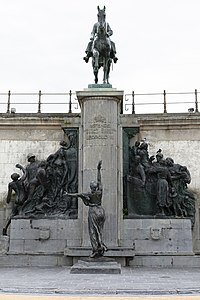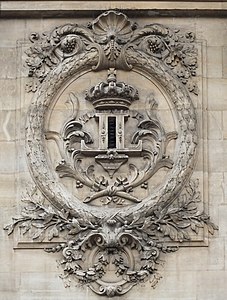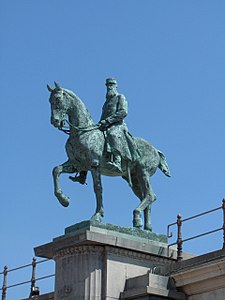|
Equestrian statue of Leopold II, Ostend
The equestrian statue of Leopold II (Dutch: Ruiterstandbeeld van Leopold II) is a monument erected in Ostend, Belgium, in memory of King Leopold II, second King of the Belgians. It is located on the Royal Galleries by the beach.[1] The king was commemorated here as a benefactor of Ostend and the Belgian Congo. The inauguration was on 19 July 1931.[1] Partly due to Leopold II's colonial regime, the monument is the subject of ongoing controversy and has been vandalised several times.[2][3][4][5] HistoryDuring King Leopold II's reign, Thomas Vinçotte produced a portrait bust of the king, which is now in the Royal Greenhouses of Laeken.[6] Shortly after the king's death in 1909, plans started to honour him, as a benefactor of Ostend and the Belgian Congo.[6] After the First World War, the city government started work on plans for a statue.[6] The sculptor Alfred Courtens was commissioned, together with his brother, the architect Antoine Courtens.[7][1] The City Council may have hoped to regain the dynasty as summer residents but after Leopold II's death, Ostend's status as a royal summer residence quickly crumbled.[6][7] On 22 September 1981, the statue was declared a protected monument.[7] DescriptionThe equestrian statue of Leopold II is known locally as De Drie Gapers ("The Three Gaps").[7][8] The middle of the three passages was made on the sea side.[9] The monument has an important architectural part that roughly consists of a voluminous upright column, with two horizontal bases on the left and right.[9] This gives a form of a kind of double L monogram (two L's turned away from each other), the monogram that Leopold II often used.[9] On top in bronze, Leopold II sits in military uniform on horseback looking over the North Sea.[9] At the bottom left a larger than life sculptural group, also in bronze, depicting Gratitude of the Congolese to Leopold II for freeing them from slavery among the Arabs.[9][1] On the right, a pendant, depicting Tribute of the Ostend fishing population.[1]
ControversyCongo Free State Leopold was the founder and sole owner of the Congo Free State; a private project was undertaken on his behalf.[10] He used the explorer Henry Morton Stanley to help him lay claim to the Congo, an area now known as the Democratic Republic of the Congo.[10] At the Berlin Conference of 1884–85, the colonial nations of Europe authorised his claim by committing the Congo Free State to improve the lives of the native inhabitants.[10] From the beginning, Leopold ignored these conditions and millions of Congolese inhabitants, including children, were mutilated and killed.[10] He used great sums of the money from this exploitation for public and private construction projects in Belgium during this period.[10] He donated the private buildings to the state before his death.[10] Leopold extracted a fortune from the Congo, initially by the collection of ivory, and after a rise in the price of rubber in the 1890s, by forced labour from the natives to harvest and process rubber.[10] Under his regime, millions of Congolese people died.[10] Reports of deaths and abuse led to a major international scandal in the early 20th century, and Leopold was forced by the Belgian government to relinquish control of the colony to the civil administration in 1908.[10] Vandalism The monument has been vandalised in 2004 and 2020.[2][3][4][5] In 2004, an activist group, De Stoete Ostendenoare, symbolically cut off a bronze hand from one of the kneeling Congolese slaves who, as part of the Gratitude of the Congolese group in the monument, honours Leopold II.[1] This was a reference to how Congolese slaves' hands were cut off if they did not produce enough rubber during Leopold's colonial regime.[1] The activists were willing to give the hand back if a historically correct sign would be placed near the statue.[11] The statue was vandalised again in 2020 as part of the global Black Lives Matter movement after the murder of George Floyd. A petition to remove such statues was started to coincide with the 60th anniversary of Congo's independence from Belgium on 30 June 2020.[2][3][4][5] On 9 June 2020, Ostend mayor Bart Tommelein said that the city council "takes the fight against racism very seriously" but "replacing or removing statues will not happen".[12] See alsoReferences
External links
|
||||||||||||||||||
Portal di Ensiklopedia Dunia





